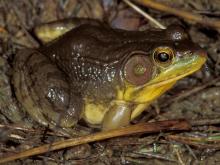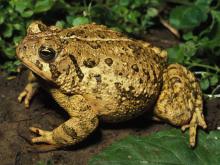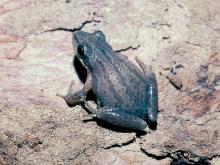Reptiles and Amphibians
Media

Species Types
Scientific Name
Notophthalmus viridescens louisianensis
Description
A small, olive-brown salamander with a fascinating life cycle, the central newt lives in and around woodland ponds and swamps in all but our far northwestern counties.
Media

Species Types
Scientific Name
Agkistrodon contortrix
Description
The eastern copperhead is the most common venomous snake in Missouri. Its color varies from grayish brown to pinkish tan, with distinctive hourglass-shaped crossbands.
Media

Species Types
Scientific Name
Coluber constrictor flaviventris (eastern yellow-bellied racer) and Coluber constrictor priapus (southern black racer)
Description
The eastern yellow-bellied racer is uniformly tan, brown, olive, blue, gray, or nearly black on top, with a yellow, cream, or light blue-gray belly. It occurs nearly statewide. The southern black racer subspecies also lives in the southeastern half of the state.
Media

Species Types
Scientific Name
Lithobates clamitans (formerly Rana clamitans)
Description
The green frog looks similar to a bullfrog but is smaller and has a ridge of skin along the sides of the back that is not found on bullfrogs. It is a game animal in Missouri.
Media

Species Types
Scientific Name
Lithobates sphenocephalus (formerly Rana sphenocephala)
Description
The southern leopard frog is an excellent jumper and quickly leaps into water when startled. From March through July, the males make chuckling or quacking calls from shallow water. Occurs statewide except for the northwestern corner.
Media

Species Types
Scientific Name
Anaxyrus americanus (formerly Bufo americanus)
Description
American toads are well-known and occur statewide. Missouri has two subspecies: the eastern American toad in the northern half, and the dwarf American toad in the southern half.
Media

Species Types
Scientific Name
Anaxyrus fowleri
Description
Fowler's toad is the common toad of gravel and sand bars along our many Ozark streams and rivers. It is also the most common toad in the Bootheel lowlands.
Media

Species Types
Scientific Name
Anaxyrus woodhousii woodhousii
Description
The Rocky Mountain toad has a number of irregular dark brown or black spots on the back and a white belly. It occurs in the Missouri River floodplain, mostly from the central to the far northwestern parts of the state.
Media

Species Types
Scientific Name
Pseudacris feriarum
Description
The upland chorus frog is a small gray or tan frog with dark dorsal stripes that are narrow or broken into a series of dashes or spots. In Missouri, it occurs only in the southeastern portion, including the southeastern Ozark Highlands as well as the Mississippi Alluvial Basin.
Media

Species Types
Scientific Name
Acris blanchardi (formerly Acris crepitans blanchardi)
Description
Blanchard's cricket frog is a nonclimbing member of the treefrog family. It lacks the adhesive toe pads associated with treefrogs. It occurs statewide. The call is a metallic “gick, gick, gick.”
See Also
About Reptiles and Amphibians in Missouri
Missouri’s herptiles comprise 43 amphibians and 75 reptiles. Amphibians, including salamanders, toads, and frogs, are vertebrate animals that spend at least part of their life cycle in water. They usually have moist skin, lack scales or claws, and are ectothermal (cold-blooded), so they do not produce their own body heat the way birds and mammals do. Reptiles, including turtles, lizards, and snakes, are also vertebrates, and most are ectothermal, but unlike amphibians, reptiles have dry skin with scales, the ones with legs have claws, and they do not have to live part of their lives in water.





















